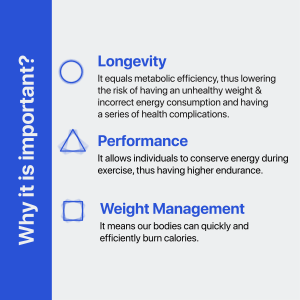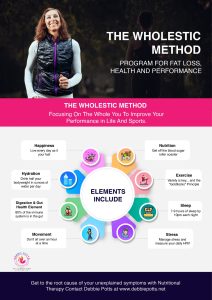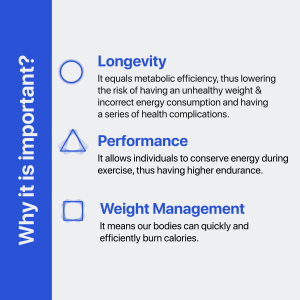Avoid the Metabolic Slow Down as you Age!
Resting resting metabolism, such as through a PNOE RMR (Resting Metabolic Rate) test, is crucial for several reasons, especially as we age and aim to avoid “metabolic slowdown.”
Here’s why it’s beneficial:
1. Understanding Baseline Caloric Needs
The RMR test measures the number of calories your body needs to maintain basic physiological functions at rest, such as breathing, circulation, and cell production. Knowing your RMR helps establish a baseline for daily caloric intake, ensuring you consume enough energy to support your metabolism and avoid unintended weight gain or loss.
2. Customized Nutrition Plans
By understanding your resting metabolism, you can tailor your nutrition to match your specific energy needs. This is particularly important as metabolism can slow down with age due to loss of muscle mass and hormonal changes. A personalized nutrition plan can help manage weight, optimize body composition, and prevent metabolic conditions like insulin resistance or metabolic syndrome.
3. Optimizing Training and Performance
Knowing your RMR allows you to better plan your training and recovery. It helps in determining the appropriate caloric intake to fuel workouts and support recovery, which is vital for maintaining muscle mass, strength, and overall performance. This is especially critical for athletes and active individuals who require precise fuel management to perform optimally.
4. Monitoring Metabolic Health
As we age, our metabolism and body composition can change. Regular testing of resting metabolism helps monitor these changes, enabling adjustments to diet and exercise routines to maintain metabolic health. This can prevent issues like muscle loss, increased body fat, and decreased energy levels.
5. Avoiding Metabolic Slowdown
Metabolic slowdown can occur due to several factors, including reduced physical activity, hormonal changes, and poor nutrition. Testing and monitoring your RMR allows you to identify any decreases in metabolic rate and take proactive steps to counteract them. This can involve adjusting macronutrient ratios, increasing protein intake, or incorporating specific training regimens to maintain or increase muscle mass.
6. Enhanced Longevity and Quality of Life
Maintaining a healthy metabolism is linked to better health outcomes, improved energy levels, and overall quality of life. By understanding and managing your metabolism, you can make informed choices that support long-term health, vitality, and active aging.
Overall, an RMR test like PNOE provides valuable insights that empower you to make informed decisions about your diet, exercise, and lifestyle, helping you perform at your best and age gracefully.
What is the PNOĒ Resting Metabolic Analysis?
At PNOĒ, we measure your metabolic rate, heart, and lung fitness in a short period of time. Our advanced system collects and analyzes your data, producing a comprehensive report. Coach Debbie Potts then correlates this information with your Nutritional Therapy Assessment and intake forms to create a personalized nutrition plan. Note: Functional lab testing assessments are available for more specific data (ask Debbie for options).
A PNOE Resting Metabolic Rate (RMR) test determines the calories burned per day by measuring the amount of oxygen your body consumes and the amount of carbon dioxide it produces while at rest.
This process is called indirect calorimetry, and it provides a highly accurate estimate of your energy expenditure. Here’s how it works:
1. Measurement of Oxygen Consumption (VO2) and Carbon Dioxide Production (VCO2)
During the test, you wear a mask connected to a metabolic analyzer that measures the volume of oxygen you inhale (VO2) and the volume of carbon dioxide you exhale (VCO2). These measurements reflect the amount of energy your body is using to maintain basic physiological functions at rest.
2. Calculating Respiratory Exchange Ratio (RER)
The ratio of VCO2 to VO2 is called the Respiratory Exchange Ratio (RER). This ratio provides information about the relative use of carbohydrates and fats as fuel sources.
3. Determining Energy Expenditure
Using the VO2 and VCO2 data, the PNOE system applies specific formulas to calculate your Resting Metabolic Rate (RMR). The RMR represents the number of calories your body requires to perform vital bodily functions at rest, such as maintaining body temperature, heartbeat, and breathing.
4. Daily Caloric Needs
To estimate your Total Daily Energy Expenditure (TDEE), which includes all calories burned throughout the day, the RMR is adjusted based on your daily activities, exercise, and other factors like age, sex, and body composition. The TDEE represents the total number of calories you need to maintain your current weight, accounting for both resting and active energy expenditures.
The PNOE RMR test provides a detailed report of your metabolic rate, including the breakdown of fat and carbohydrate utilization and the overall caloric needs. This data helps in designing personalized nutrition and training plans that match your specific metabolic profile, ensuring you get the right amount of energy and nutrients to support your health and performance goals.
Why Get a Resting Metabolic Test?
Your Resting Metabolic Rate (RMR) is your body’s baseline caloric requirement.
Knowing your RMR enables you to:
- Craft Individualized Calorie Intake Targets: Tailor your diet to help you lose, gain, or maintain your weight.
- Verify Program Effectiveness: Assess if a training or nutrition program has increased or decreased your metabolism.
- Compare Metabolism: Understand how your metabolism compares to others of your gender, age, height, and weight.
Resting Metabolic Assessment Procedure
- Make an Appointment:
- Schedule your RMR appointment online here.
- You can cancel or reschedule up to 24 hours beforehand.
- Preparation:
- Refrain from strenuous exercise for at least 12 hours before the test.
- Avoid eating for at least 5 hours and using caffeine or nicotine for at least 6 hours before the test.
- During the Test:
- Lie down on our recliner for about 10 minutes.

- Breathe into a mask that collects and analyzes your exhaled air.
- Lie down on our recliner for about 10 minutes.
- Post-Test:
- Coach Debbie Potts will follow up with a detailed report and an action plan with specific recommendations.
Summary
A metabolic slowdown can be a significant obstacle to achieving your dream physique and maintaining long-term health. Monitoring your metabolism is crucial to prevent or address declines in metabolic rate. The PNOĒ metabolic analyzer provides a clinical-grade analysis of your metabolism, helping you act early to avoid the pitfalls of a metabolic slowdown.
Contact Information
Get your PNOĒ metabolism test and Nutritional Therapy Assessment today with Coach Debbie Potts. Visit debbiepotts.net for more information and to schedule your appointment.
Contact Coach Debbie Potts for more information and packages listed on https://debbiepotts.net/pnoe/
What about PNOE Exercise Test to determine your Training Zones?
The PNOE exercise test helps determine heart rate zones and guides interval training by analyzing your physiological responses during exercise.
Here’s how PNOE works and how to apply this information for effective training:
1. Determining Heart Rate Zones
During the PNOE exercise test, you wear a mask connected to a metabolic analyzer while performing graded exercise (usually on a treadmill or cycle ergometer). The test progressively increases intensity, allowing the system to measure various physiological parameters, including:
- Heart Rate (HR)
- Oxygen Consumption (VO2)
- Carbon Dioxide Production (VCO2)
- Respiratory Exchange Ratio (RER)
- Ventilatory Thresholds (VT1 and VT2)
These measurements help identify key points like the ventilatory thresholds, where the body’s metabolism shifts. These thresholds correspond to the transition points between aerobic and anaerobic energy systems and are used to delineate different heart rate zones:
- Zone 1: Very light activity, mostly aerobic, below VT1.
- Zone 2: Light aerobic activity, still below VT1.
- Zone 3: Moderate aerobic activity, between VT1 and VT2.
- Zone 4: High-intensity activity, predominantly anaerobic, around VT2.
- Zone 5: Maximal effort, above VT2, anaerobic.
2. Interval Training Protocols
Interval training involves alternating periods of high-intensity exercise (e.g., Zones 4 and 5) with lower-intensity recovery periods (e.g., Zone 1). The goals of these intervals vary based on the specific adaptations sought, such as improved speed, power, or mitochondrial function.
- Zone 4 Intervals: These are typically longer intervals at a high intensity, focusing on improving lactate threshold and aerobic power. For example, you might perform 3-5 minutes in Zone 4, followed by recovery periods.
- Zone 5 Intervals (Sprint Intervals): These involve shorter, maximal efforts to improve anaerobic capacity, speed, and power. Intervals can range from 20 seconds to 1 minute at Zone 5, with longer recovery times due to the intensity.
3. Recovery in Zone 1
Recovery in Zone 1 is crucial during high-intensity interval training (HIIT) or sprint interval training (SIT) for the following reasons:
- Active Recovery: Staying in Zone 1 during recovery helps maintain blood flow, which aids in lactate clearance and reduces muscle stiffness.
- Preparation for Next Interval: By keeping the heart rate low, Zone 1 recovery allows your body to partially replenish energy stores (like phosphocreatine) and prepare for the next high-intensity effort.

- Cardiovascular Adaptation: Alternating between high and low heart rate zones can improve cardiovascular efficiency and heart rate recovery.
4. Application to Training
To optimize training and achieve specific goals, you can structure your intervals and recovery periods based on the identified heart rate zones:
- Speed and Power: Use shorter intervals (Zone 5) with longer recovery periods (Zone 1) to focus on explosive power and speed.
- Endurance and Threshold Improvement: Use longer intervals (Zone 4) with shorter recovery periods (Zone 1) to improve aerobic capacity and lactate threshold.
5. Monitoring and Adjusting
Using the data from the PNOE test, you can monitor your heart rate and adjust the intensity and duration of intervals and recovery periods. This ensures you are training at the correct intensity to maximize the desired adaptations, whether improving speed, power, endurance, or overall metabolic efficiency.
Regular reassessment with tools like the PNOE test can help track progress and adjust training zones as your fitness level improves. This personalized approach maximizes the effectiveness of your training and helps you achieve your performance goals.
Quick Summary:
- What: PNOĒ Resting Metabolic Analysis
- Why: To measure and optimize your caloric expenditure and fat burning at rest.
- Procedure: Make an appointment, follow preparation guidelines, complete the test, and receive a detailed report and action plan.
- Contact: debbiepotts.net
Don’t let a metabolic slowdown hinder your progress. Take control of your health and fitness with PNOĒ and Coach Debbie Potts!
Who is Coach Debbie Potts?
Debbie Potts has been a dedicated professional in the health and fitness industry for over twenty-five years and a competitive endurance athlete for twenty years. She has achieved numerous milestones, including being nominated as one of the top one hundred best trainers in the U.S. by Men’s Journal in 2004 and 2005. Debbie has participated in fifteen Ironman Triathlons, including five appearances at the Hawaii World Ironman Championship.
For twelve years, Debbie owned and operated a fitness studio in Bellevue, Washington, offering an “all-in-one” health and fitness experience. This included The WHOLESTIC Method coaching programs and individualized Nutritional Therapy services aimed at transforming the whole person from the inside out.
In the summer of 2020, Debbie moved from Bellevue to North San Diego to enhance her quality of life after battling “Adrenal Exhaustion,” chronic fatigue, and “metabolic chaos” since 2013. She authored the book “Life is Not a Race – It is a Journey” to share her experiences and help other ambitious high performers avoid the pitfalls she encountered despite doing all the “right” things.
Debbie’s educational background includes:
- BA in Exercise Science & Corporate Fitness
- ACSM Health Fitness
- Natural Running Coach with Newton
- NASM Certified Personal Trainer
- Metabolic Efficiency Specialist with Bob Seebohar
- USA Triathlon Certified Coach Level One
- Superhuman Coach & Kion Coach for Ben Greenfield
- CHEK Holistic Lifestyle Coach (HLC)
- Certified Functional Nutritional Therapy Practitioner (F-NTP)
- Certified Functional Diagnostic Nutrition Practitioner (FDN-P)
- Metabolic Expert Certification (PNOE) with Daniel Crumback
- Stacy Sims Menopause 2.0 Course 2023
- Designs for Health Supplement certification (current)
- Wild Health Precision Medicine Fellowship 2024
- NBHWC Board Certification in winter 2024
- Certified CPR & AED
Debbie has shared her expertise as the owner of Fitness Forward Studio, creator of The WHOLESTIC Method, and host of The Low Carb Athlete podcast. Her career highlights include competing in over fifteen Ironman Triathlons and numerous marathons, including the Boston Marathon with a personal record of 3:12.
Debbie is passionate about coaching high performers to reclaim their vibrant selves by investigating underlying health issues and putting the missing pieces of their unique health puzzles back together. She aims to help clients become fat burners, optimize health, and enhance performance in life and sports through The WHOLESTIC Method.
Debbie’s journey from a top age-group triathlete, marathoner, and cyclist to a coach recovering from burnout has fueled her mission to help others avoid similar experiences. She offers comprehensive programs like The WHOLESTIC Method’s 5-day and 30-day total transformation detox, repair, and rebuild plans to improve health at a cellular level.
Her book, “Life is Not a Race,” and her podcast, “The Low Carb Athlete,” emphasize pacing oneself and transforming the whole athlete from the inside out with her unique coaching approach.
LIFE IS NOT A RACE… It is a Journey! Pace the WHOLE You with The WHOLESTIC Method.
